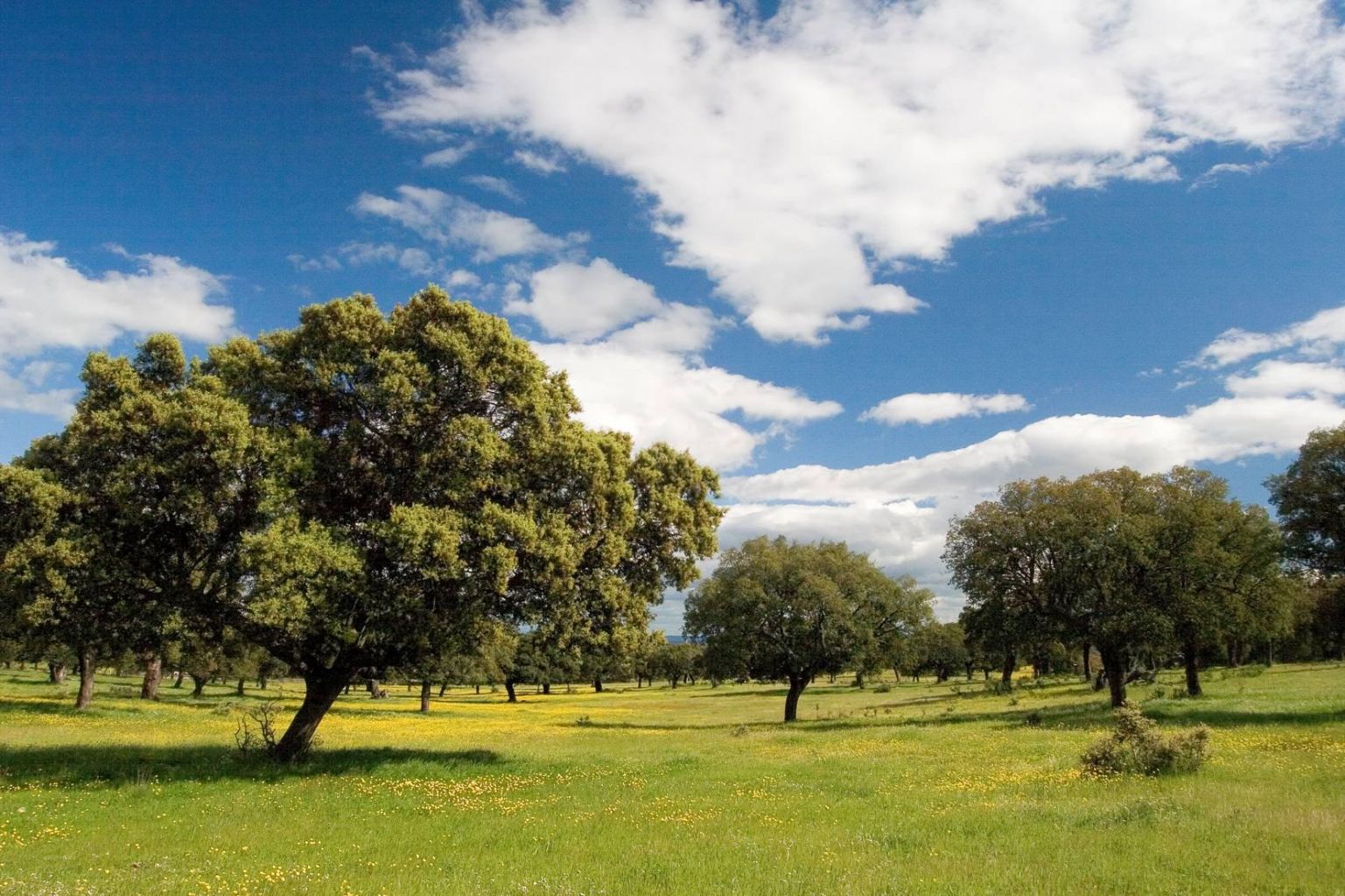
Il sistema Dehesa in Spagna
Descrizione del sistema
Dehesa è il nome di un sistema agrosilvopastorale costituito da querce sempreverdi (leccio), specie erbacee spontanee, colture agrarie e attività pascoliva. L’estensione del Dehesa è stimata in circa 2.3 milioni di ettari in Spagna e in circa 0.7 milioni di ettari in Portogallo dove prende il nome di Montado. Il Dehesa può essere considerato come il risultato ottenuto dalla semplificazione, in termini di struttura e composizione specifica, delle foreste Mediterranee in cui è ridotta la densità arborea e quella arbustiva, a vantaggio in questo modo dello sviluppo delle specie erbacee, per mezzo dell’attività pascoliva ed agricola. Il Dehesa si caratterizza per l’impiego di razze animali tradizionali a bassa intensità di allevamento e attenta utilizzazione delle componenti arboree. Per queste caratteristiche, il Dehesa è il sistema agroforestale estensivo meglio conservato in Europa e in cui è perfetta l’integrazione tra necessità di uso del suolo e conservazione della biodiversità.
Meeting iniziale con gli stakeholders
Il primo meeting con il gruppo di stakeholders è stato organizzato il 30 maggio 2014 alla Scuola Forestale dell’Università di Extremadura a Plasencia (Spagna). Il meeting ha avuto un notevole successo in termini di partecipazione: erano presenti circa 90 stakehodlers tra cui imprenditori agricoli, allevatori, forestali, proprietari terrieri, rappresentanti di organizzazioni di categoria nazionali e regionali, divulgatori, NGO (Organizzazioni Non Governative), GAL (Gruppi di Azione Locale) ed autorità politiche. Durante il meeting è stata condotta un’analisi delle percezioni negative e positive da parte dei partecipanti nei riguardi dei sistemi agroforestali di elevato valore naturale e culturale e sono state individuate le innovazioni da sperimentare con il progetto AGFORWARD. I principali temi di ricerca identificati sono: metodi per migliorare la rinnovazione naturale delle componenti arboree, miglioramento delle specie erbacee per il pascolo, miglioramento dei sistemi di pascolo, e le possibilità di mercato dei prodotti.
Per maggiori informazioni, contattare Dr. Gerardo Moreno all’Università di Extremadura.
Download the initial stakeholder report
Download the initial research and development protocol
Download the system description
A research update on dehesas in Spain was produced in December 2015.
Lessons learnt
Gerardo Moreno and colleagues at the University of Extremadura have written a comprehensive and informative report on the various innovations tested within the Dehesa stakeholder group in Spain.
The first part of the report focus on the search of alternative low cost shelters and practices for the regeneration of the trees of the dehesa. Some of the main lessons learnt are:
- Tree regeneration in the dehesa needs to be an integrated part of regular management practice; a rotational stage of grazing exclusion could be included in long-term farm management plans.
- Assisted regeneration can be based either on seeding acorns or on planting nursery-grown seedlings. Both approaches require seed and/or seedling protection.
- Application of cat/dog excrement around sown acorns can be recommended for small scale reforestation. CHANGE around young plants BY acorns sown
- Thorny wire-mesh tree guards proved to be an efficient, long-lasting solution and cheaper form of tree protection than classic wire mesh tree guards.
The second part of the report focuses on the option to improve fodder self-sufficiency by using protein-rich fodder crops and self-seeding pastures. Some of the main lessons learnt are:
- Three varieties of triticale are recommended; the trees can increase winter forage yields and the quality of the forage. The triticale can be grazed by livestock in the winter before the start of stem elongation.
- The sowing of legume-rich self-reseeding pasture can increase pasture productivity and quality for at least a decade. Grazing needs to be delayed in the initial years to ensure good establishment.
- The increase in the soil nitrogen, due to the legumes, also increases the protein content of other pasture species.
- The sowing of pasture increased the soil content of carbon accumulated. Although it reduced slightly the α diversity of plants, the total species richness (ϒ diversity) was unaltered.
- Farmers in the study reported that the improvement in the pasture quality and productivity offset the costs of the seed mixture and fertilizers.
The third part of the report focused on consumer acceptance for dehesa products and services. Some of the lessons learnt are:
- Consumers were more familiar with the term "dehesa" than "agroforestry"
- Consumers associated the dehesa with high-quality livestock products and a landscape of high cultural value.
- Possible dehesa products with development potential include asparagus, fungi and mushrooms, acorn-based foods, medicinal plants and cosmetics, herbs and herbal tea. CHANGE acorn beer BY acorn-based foods
Lastly the report highlights that more research is still needed on the use of new technologies (such as GPS collars) to improve dehesa management and the use of fast-intensive rotational management. Preliminary results also indicate that (ignoring the methane produced by livestock), a positive annual carbon balance of the dehesa of Majadas of about 0.5 t C/ha.